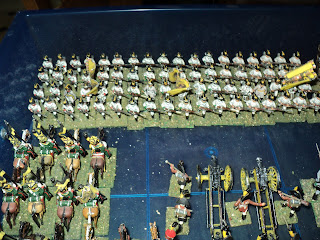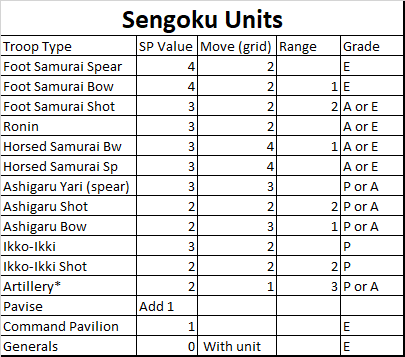Turn Six (and Seven): The Allies seize the initiative:
In doing so, they repulse Marshal Victor's assaults upon Surville and St Martin once and for all. Very little remains of the Line Divisions, or of the Paris Reserve. Now, were Victor alne in this fight, his corps would have routed long ago - and many rule sets would have prescribed precisely that. In my view, although such a rule in fine for the overall army command, it is 'double jeopardy' for the army's constituent formations. Victor has just 6 Strength Points remaining. Very well: what has happened to the other 12? There is your rout. Apart from killed, wounded and captured, thousands of stragglers are milling about the battlefield. A tiny group of brave men remain with the colours, and remain in the fight. That the other formations are still taking it to the enemy is also keeping Victor's command in being.
Well, that's my rationale, anyhow.
But fortunes elsewhere on the battlefield are at best mixed. Kirsch's Austrians and the Wurttemberg Light Infantry are pushing Milhaud's tired cavalry back towards Luat, but a cavalry battle raging close by Surville is holding up the river crossing by Bianchi's Corps.
What happened to the Bavarian breakout? Somehow their fate escaped the attention of the battlefield artist. Although driving off Pajol's hussars, they drew the attention of the powerful brigades of the National Guard. Heavily outmatched, the Bavarians did not long survive the encounter. The victorious National Guard continued marching on towards Villerton.

In the meantime, the long column of Bianchi's I Corps remained held up along the road, unable to move until the Surville garrison clear the streets of the town.

The dragoons reinforcing Pajol's chasseurs, the long drawn out running battle with Walsleben's cavalry came to a sudden end with the latter's collapse. Suddenly Kirsch's artillery line was threatened from a flank...
... and it was now that the portentous dark cloud began to blanket the fields to the north: the Emperor Napoleon, and the Imperial Guard. Exelmans's light horse and Delort's heavies, led by Nansouty (wearing a chasseur uniform in this day), advanced across the fields, whilst Friant's Old Guard took the road through Forges to Luat.
As Milhaud and victor pull back from St Martin towards Luat, Schafer and Doring's brigades follow up. By so doing they clear the road for Bianchi's delayed troops to cross the river into Surville.

Led by General Koch himself, Austrians and Wurttembergers drive the formed remnants of Duhesme's Division upon the equally depleted Paris Reserve. Marshal Victor rallies what is left of his infantry in a new line.

Turn Eight: The Allies keep the initiative.
The quick-witted and observant reader will wonder what happened to Turn 7, and so do I. I think I simply forgot around this time to take enough pictures, and thereby omitted the move marker. However the previous two pictures seem sufficient to me to indicate two turns had gone by, as Koch drove back Victor's Corps well away from the riverside towns.
The streets of Surville now unencumbered, Bianchi's column begins to pour across the bridges. Then comes another hold-up. Barely emerging from the western outskirts of Surville, Raigecourt's cavalry run into Milhaud's chasseurs. This is doubly bad news, for the chasseurs shortly before have overrun Austrian artillery that had formed a battery line between St Martin and Villeron. Bianchi's column seems to be facing more delays.

However, Raigecourt does receive some support from some of Bianchi's artillery detached and in battery in a loop of the river, firing into the flank of Pajol's horse. On the other hand French pressure has been so determined, that the Wurttemberg advance guard infantry have now been cut off in Villeron and are under heavy assault from Pacthod's National Guardsmen.
All this while, the Imperial Guard continues to pour into the battlefield. The leading elements of the Old Guard are marching through Luat, where they are greeted by Milhaud's dragoons. The Guard cavalry remain north of the Luat-Piat Buisson road.
However depleted Victor's command, supported by Milhaud's horse artillery, continue to stand against the Allied counter-attacks. The artillery repulse a brigade sized Austrian attack, and drive the assailants back into St Martin.

It is becoming apparent that the Imperial Guard can reinforce the French attacks far more quickly than can Bianchi the beleaguered bridgehead. Unable to break out into the open, Raigecourt's cavalry are clogging the streets of Surville. It is only the stout resistance of the green-coats in Villeron that has delayed Pacthod's advance upon the riverside town.
The situation indicating that there was no real prospect now of expanding the bridgehead, let alone saving the garrison of Villeron, Prince Eugene of Wurttemberg sounds the retreat. Darkness drawing in upon a late winter afternoon, the Allies are able, less the Villeron garrison, to pull back across the river overnight. With no escape, Stockmeyer's Wurttemberg advance guard surrender themselves after dark. Otherwise, there was no pursuit.
Undoubted French victory though reported in the Bulletin, there was no question that the Grand Armee had received a severe knock. Marshal Victor's Army Corps had lost over half the total French losses, and they fell just barely short of the Army's exhaustion point. For their part, the Allies had lost just 26SP not counting a divisional commander (Walsleben) and also not counting what remained to surrender of Stockmeyer's light infantry.




























































